After you’ve gotten used to doing ollies, the next trick you will likely be eager to learn is the ‘Kickflip.’ The act of catching the board in the air after it makes a full rotation underfoot and then sticking the landing is commonly one of the best moments in any skateboarder’s early progression. It can take days or weeks or even months to learn depending on the skater and the amount of practice invested. To help you practice, here is your guide for learning to kickflip!
What is Kickflip?
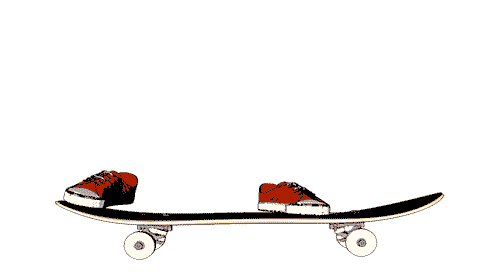
The kickflip (formally known as the “Magicflip”) is a maneuver in which the skater’s front foot flips the board during an ollie with a slight ‘kicking’ (more a flick of the foot in actuality) motion. The kickflip is the basic foundation of numerous more complicated flip tricks. As with many other tricks, the creation of the kickflip is a credit to Rodney Mullen.
How to Flip the Board?
The rotation of the board depends on how you maneuver your front foot during a well executed ollie. As you drag your front foot toward bringing the board level to the ground, as with an ollie, flick the board with a deft ‘kick’ (again, more of a flick in actuality) of your front foot. Practice keeping balanced and above the board!
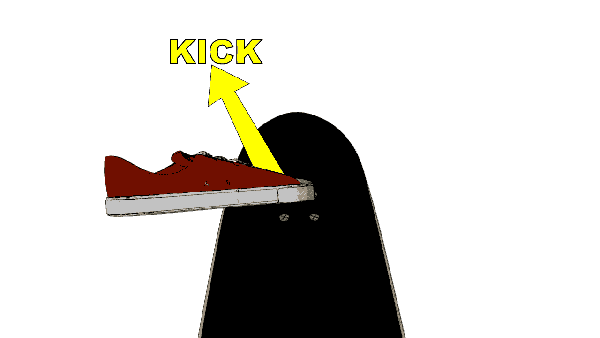
How to Kickflip?
You must be able to ollie as a prerequisite to the kickflip, as the kickflip is essentially a slightly modified ollie. If you are not able to ollie about 1 foot (30cm) consistently, it is probably best to keep practicing your ollie before moving onward to the kickflip. Our tutorial post for the ollie may help you.
Stance for Kickflip
The kickflip stance is similar to the ollie stance save for the positioning of your front foot. Your front foot should be drawn back slightly off the board and its angle changed slightly so as to facilitate the imminent ‘kick’ (flick of the foot). The stance may render you slightly unsteady after you’ve gotten used to the ollie stance but try to keep your balance. At this point your body should be developing an intuitive sense of how to compensate for changes in stance which allow it to maintain a centered and well balanced distribution of weight over the board.
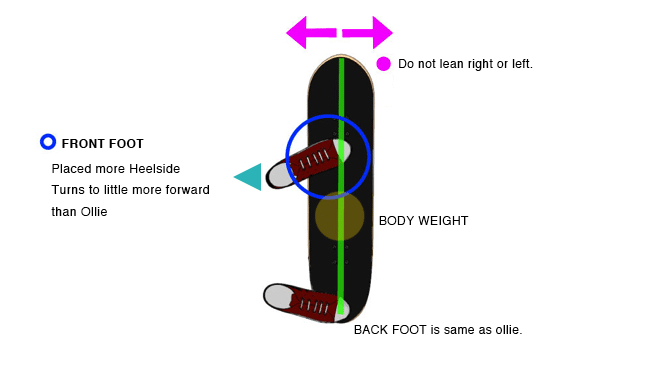
Body Direction
The direction of you body’s jump is something to keep in mind as you practice your kickflips. Your body should jump more upward than forward in order to allow the maneuvering front foot its optimal range of motion.

Body Anticipation
Keeping in mind the subtle difference of the front foot (angled in slightly and drawn back slightly toward the heel end of the board) in the preparatory stance, perform an ollie as you regularly would.
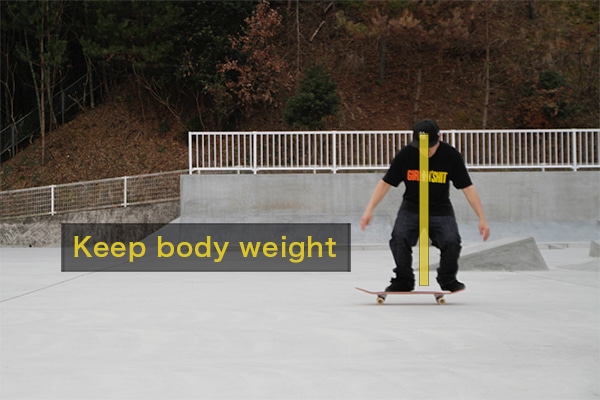
Kicking Tail
Kick down on the tail with your back foot strong enough to make the now familiar pop/cracking sound. The motion is nearly identical to that of the ollie but your mind now will have to be focused on the flipping aspect of the trick.
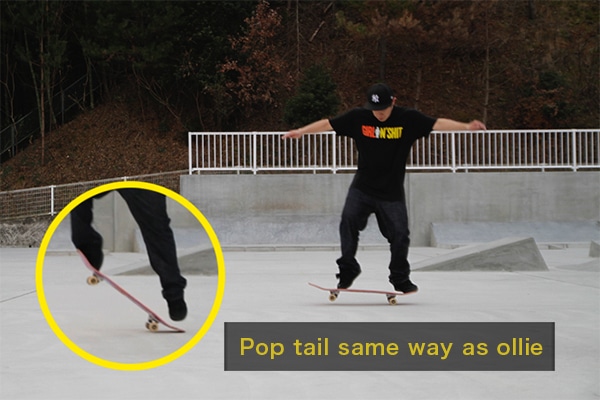
Dragging Nose and ‘Kicking’ Out
Your front foot must drag the nose after popping the tail for the same leveling off reason that is required to perform an ollie. This time, however, focus on using your toes a little more than you might for an ollie. As the toe area of your front foot reaches the nose, use a flicking motion diagonally outward and forward. The height of your kickfip depends on how high you are able to allow the nose of your skateboard to level/nearly level off before ‘kicking’ out.
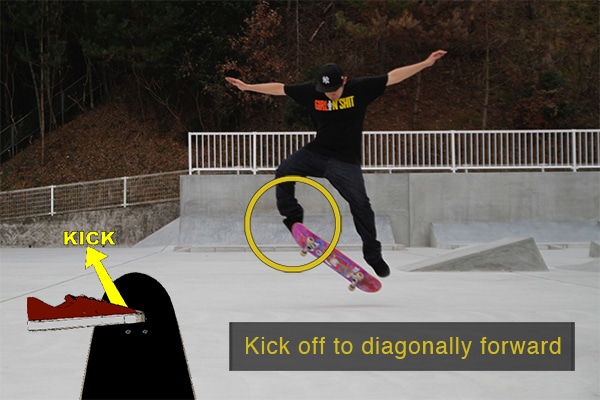
Keeping Balance and Watching the Board Rotate
As you develop a sense of how it feels to have the board rotating underfoot, watch your board as it rotates, and practice staying over it! Jump up, not off, and don’t forfeit your balance as you kick the board underfoot. Skaters proficient at the kickflip do not make unnecessary movements to produce spin. They use barely more then their front foot. Keep practicing!
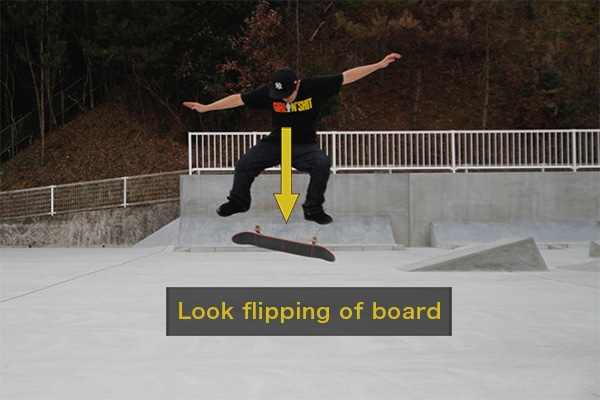
Catching the Board in the Air
This is a great moment for any skater popping a kickflip. If you’ve kept a balanced body above the board, and if you’ve been efficient but effective with the movement of your front foot, all you need to do is to time your ‘catch’ for when the board underfoot completes its rotation. Easier said than learned for sure, but take heart! Once you truly get a sense for the kickflip, subsequent flip tricks should come much more naturally. Keep your mind focused on how your body must anticipate and adapt in order to stay balanced above the board.

Landing
If you’ve focused on and done a good job at maintaining your balance above the board, you should be able to guide your feet so that they are positioned over the hardware of your board when you land. In this way the stress of impact on the board upon landing should be absorbed by the wheels.

Absorbing the Shock of Landing
As for the stress of impact on your body upon landing, use your knees to absorb the shock, as you would with a well-done ollie. The ability to absorb shock upon landing is critically important when attempting larger stairs or gaps.

This sequence shows the minimal movement of the body and the head during the kickflip process

Q&A
Q : I have a hard time getting my feet back over the board after I flip it. What should I do?
This is a common concern for many flat-ground tricks. Failure to pay close focus on the body’s balance and jump as well as over aggressive kicking motions are often most responsible for this issue. Everyone is a little different so it’s hard to generalize, but let’s keep in mind and re-examine the importance of process and learning how to properly flip the board underfoot.
Steps for Learning Flip Tricks
1. First Develop a Familiarity with the Flip. Don’t Over-Concern Yourself with Landing.
When you practice flip tricks, often times the skateboard will spin in unfavorable directions and smack you. Trying to land with both feet despite a lack of familiarity and comfort with the proper flipping maneuver is often responsible for this. Practice getting used to flipping your board. At the early stages of learning the kickflip, it can be very beneficial to put your back foot on the ground immediately after kicking the tail so that without fear of falling you may use only your front foot to learn the fundamentals of spinning the board.
2. Learning Landing Motion.
Step1 is a learning technique for the safe practice of flipping. Many people who’ve sent us questions have gotten stuck at this stage. Your body will instinctively try to prevent your feet from landing on the skateboard when you are in the learning process. Keep practicing until your body begins to trust your mind’s intent. Jump up, keep your flip motion efficient, stay over your board, and the landing should come naturally. Just remember that you can’t land on the board if your feet hit the ground before the skateboard itself, obviously. Stay above the board!
3.Taking Your Kickflip with You on the Road
Once you begin to land kickflips with some regularity, focus next on polishing up your style by ‘catching’ the board while it’s still in the air. Be efficient with your movements. When you get a consistently smooth, high kickflip, you can take it with you wherever you go. As we say in a Japanese-style English, “Smooth-high kickflip make you cool for many spots!”
If you’ve been stuck on step2 for some time and really want some personalized insight on why you’re having difficulty landing, you may send us some footage of your attempts and ask what’s wrong via the request link (under ‘how to’ above.) So yeah, feel free to ask.
